ATMC BUS503 Principles of Commercial Law: Negligence Assignment
VerifiedAdded on 2022/12/20
|7
|2211
|1
Report
AI Summary
This assignment report meticulously analyzes a commercial law case concerning negligence, specifically addressing issues of duty of care, breach of duty, and the determination of damages. It explores the application of legal principles such as the Caparo test and the neighbor principle, drawing on case law like Donoghue v Stevenson to establish a framework for assessing liability. The report examines the manager's responsibilities, the foreseeability of risk, and the concept of contributory negligence. Furthermore, it evaluates the damages sustained by the claimant, including physical and economic losses, concluding with a comprehensive overview of the legal and financial implications of the case. The analysis emphasizes the importance of managerial duties in preventing negligence and the potential defenses available to the defendant.
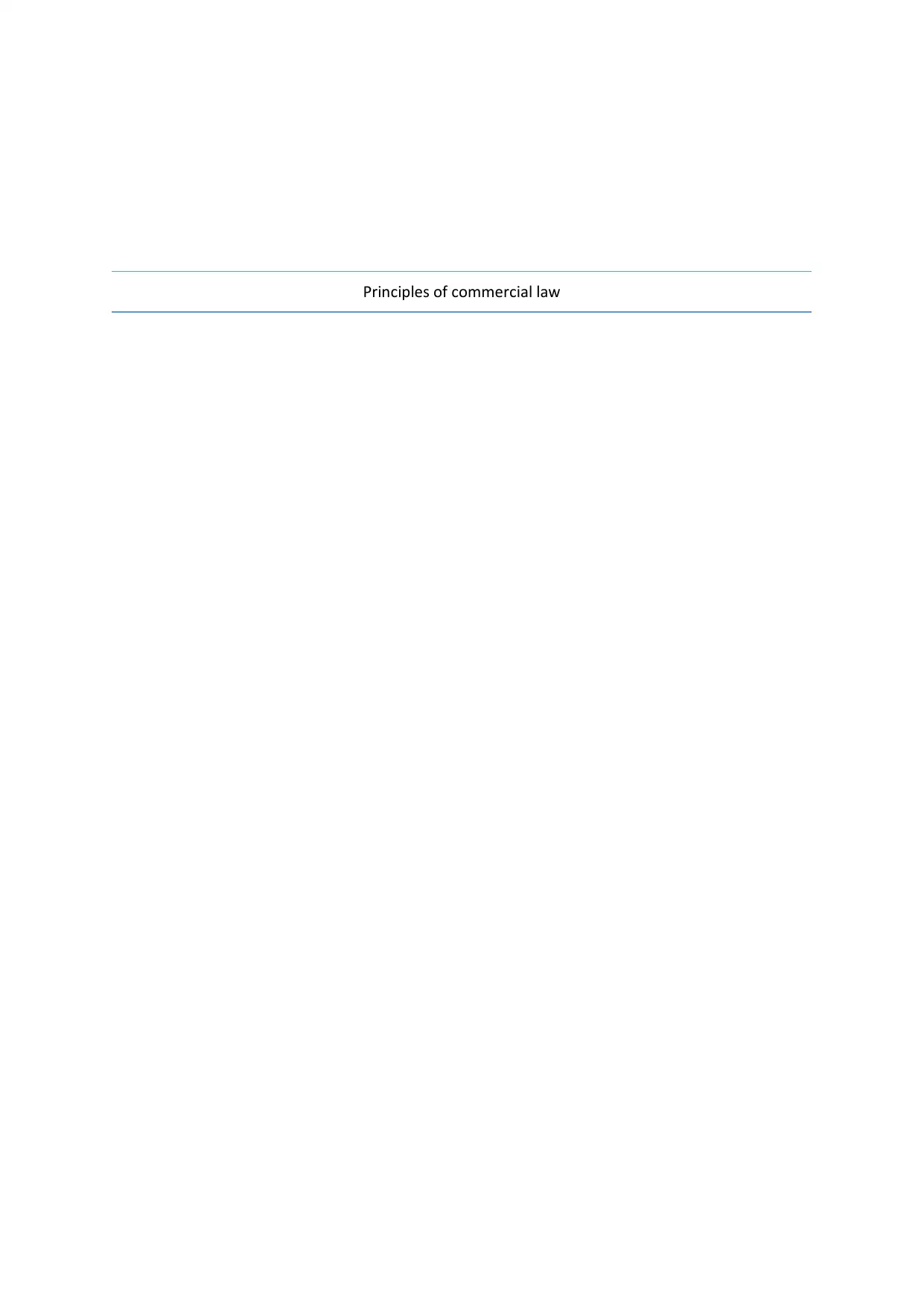
Principles of commercial law
Paraphrase This Document
Need a fresh take? Get an instant paraphrase of this document with our AI Paraphraser
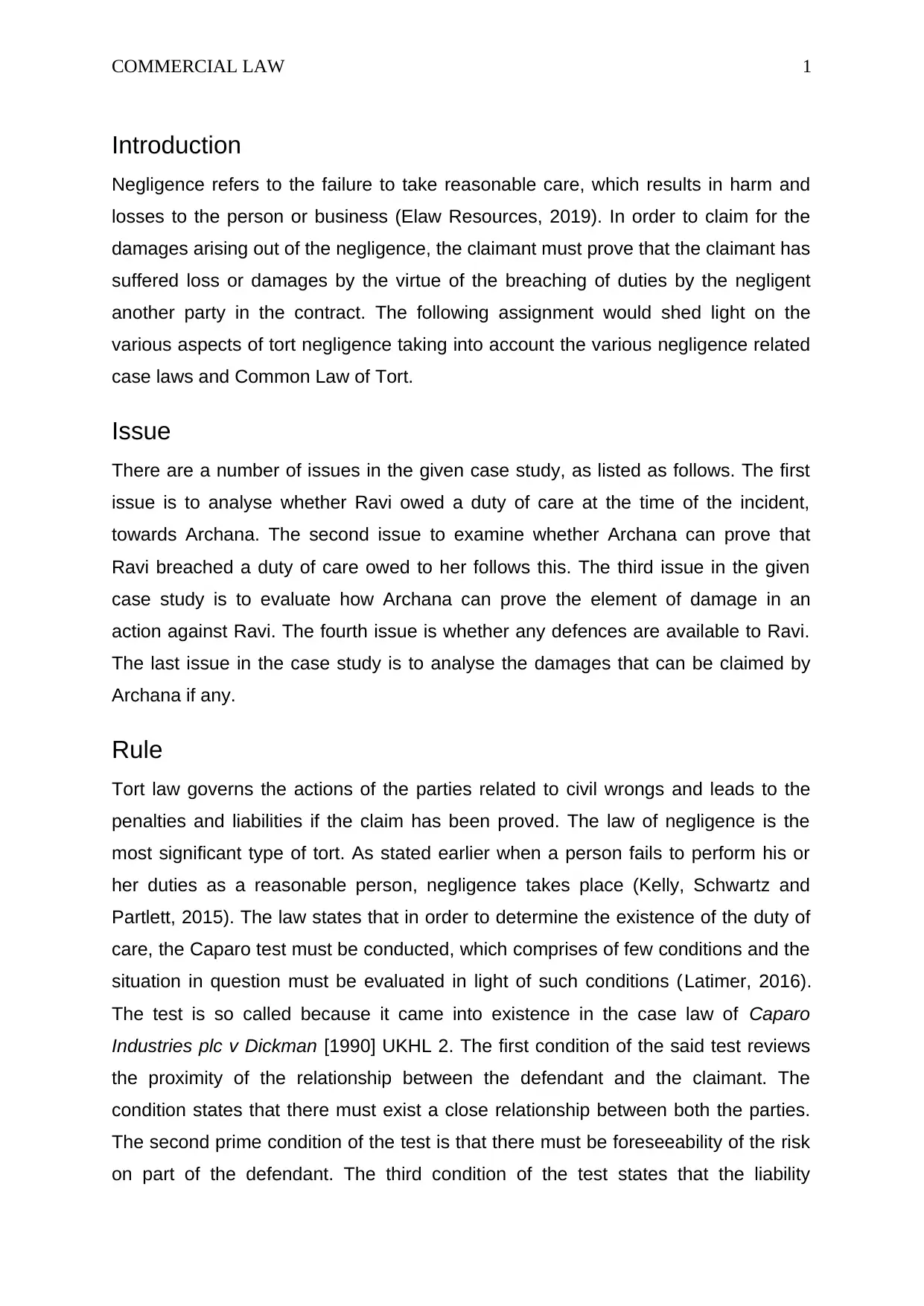
COMMERCIAL LAW 1
Introduction
Negligence refers to the failure to take reasonable care, which results in harm and
losses to the person or business (Elaw Resources, 2019). In order to claim for the
damages arising out of the negligence, the claimant must prove that the claimant has
suffered loss or damages by the virtue of the breaching of duties by the negligent
another party in the contract. The following assignment would shed light on the
various aspects of tort negligence taking into account the various negligence related
case laws and Common Law of Tort.
Issue
There are a number of issues in the given case study, as listed as follows. The first
issue is to analyse whether Ravi owed a duty of care at the time of the incident,
towards Archana. The second issue to examine whether Archana can prove that
Ravi breached a duty of care owed to her follows this. The third issue in the given
case study is to evaluate how Archana can prove the element of damage in an
action against Ravi. The fourth issue is whether any defences are available to Ravi.
The last issue in the case study is to analyse the damages that can be claimed by
Archana if any.
Rule
Tort law governs the actions of the parties related to civil wrongs and leads to the
penalties and liabilities if the claim has been proved. The law of negligence is the
most significant type of tort. As stated earlier when a person fails to perform his or
her duties as a reasonable person, negligence takes place (Kelly, Schwartz and
Partlett, 2015). The law states that in order to determine the existence of the duty of
care, the Caparo test must be conducted, which comprises of few conditions and the
situation in question must be evaluated in light of such conditions (Latimer, 2016).
The test is so called because it came into existence in the case law of Caparo
Industries plc v Dickman [1990] UKHL 2. The first condition of the said test reviews
the proximity of the relationship between the defendant and the claimant. The
condition states that there must exist a close relationship between both the parties.
The second prime condition of the test is that there must be foreseeability of the risk
on part of the defendant. The third condition of the test states that the liability
Introduction
Negligence refers to the failure to take reasonable care, which results in harm and
losses to the person or business (Elaw Resources, 2019). In order to claim for the
damages arising out of the negligence, the claimant must prove that the claimant has
suffered loss or damages by the virtue of the breaching of duties by the negligent
another party in the contract. The following assignment would shed light on the
various aspects of tort negligence taking into account the various negligence related
case laws and Common Law of Tort.
Issue
There are a number of issues in the given case study, as listed as follows. The first
issue is to analyse whether Ravi owed a duty of care at the time of the incident,
towards Archana. The second issue to examine whether Archana can prove that
Ravi breached a duty of care owed to her follows this. The third issue in the given
case study is to evaluate how Archana can prove the element of damage in an
action against Ravi. The fourth issue is whether any defences are available to Ravi.
The last issue in the case study is to analyse the damages that can be claimed by
Archana if any.
Rule
Tort law governs the actions of the parties related to civil wrongs and leads to the
penalties and liabilities if the claim has been proved. The law of negligence is the
most significant type of tort. As stated earlier when a person fails to perform his or
her duties as a reasonable person, negligence takes place (Kelly, Schwartz and
Partlett, 2015). The law states that in order to determine the existence of the duty of
care, the Caparo test must be conducted, which comprises of few conditions and the
situation in question must be evaluated in light of such conditions (Latimer, 2016).
The test is so called because it came into existence in the case law of Caparo
Industries plc v Dickman [1990] UKHL 2. The first condition of the said test reviews
the proximity of the relationship between the defendant and the claimant. The
condition states that there must exist a close relationship between both the parties.
The second prime condition of the test is that there must be foreseeability of the risk
on part of the defendant. The third condition of the test states that the liability
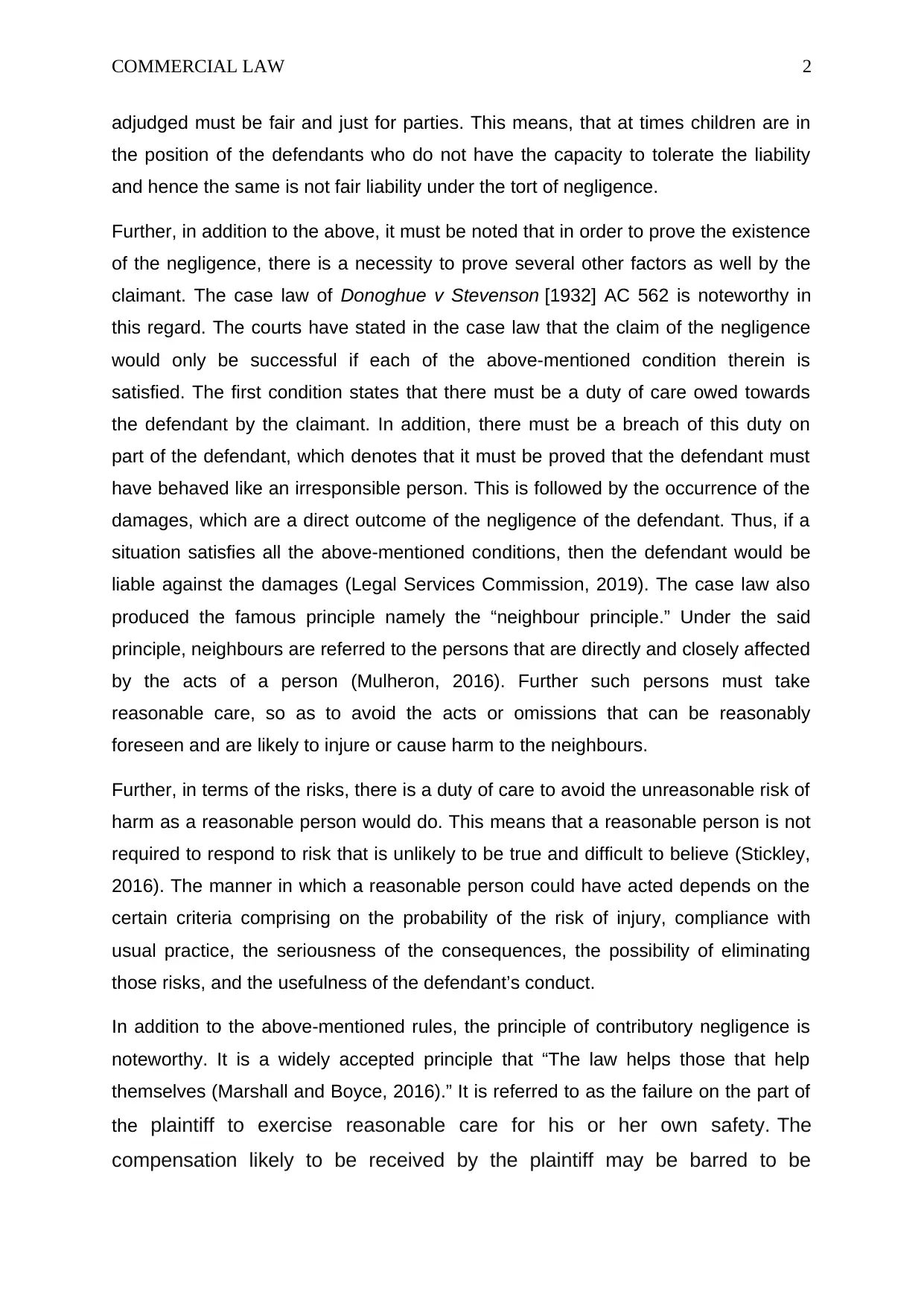
COMMERCIAL LAW 2
adjudged must be fair and just for parties. This means, that at times children are in
the position of the defendants who do not have the capacity to tolerate the liability
and hence the same is not fair liability under the tort of negligence.
Further, in addition to the above, it must be noted that in order to prove the existence
of the negligence, there is a necessity to prove several other factors as well by the
claimant. The case law of Donoghue v Stevenson [1932] AC 562 is noteworthy in
this regard. The courts have stated in the case law that the claim of the negligence
would only be successful if each of the above-mentioned condition therein is
satisfied. The first condition states that there must be a duty of care owed towards
the defendant by the claimant. In addition, there must be a breach of this duty on
part of the defendant, which denotes that it must be proved that the defendant must
have behaved like an irresponsible person. This is followed by the occurrence of the
damages, which are a direct outcome of the negligence of the defendant. Thus, if a
situation satisfies all the above-mentioned conditions, then the defendant would be
liable against the damages (Legal Services Commission, 2019). The case law also
produced the famous principle namely the “neighbour principle.” Under the said
principle, neighbours are referred to the persons that are directly and closely affected
by the acts of a person (Mulheron, 2016). Further such persons must take
reasonable care, so as to avoid the acts or omissions that can be reasonably
foreseen and are likely to injure or cause harm to the neighbours.
Further, in terms of the risks, there is a duty of care to avoid the unreasonable risk of
harm as a reasonable person would do. This means that a reasonable person is not
required to respond to risk that is unlikely to be true and difficult to believe (Stickley,
2016). The manner in which a reasonable person could have acted depends on the
certain criteria comprising on the probability of the risk of injury, compliance with
usual practice, the seriousness of the consequences, the possibility of eliminating
those risks, and the usefulness of the defendant’s conduct.
In addition to the above-mentioned rules, the principle of contributory negligence is
noteworthy. It is a widely accepted principle that “The law helps those that help
themselves (Marshall and Boyce, 2016).” It is referred to as the failure on the part of
the plaintiff to exercise reasonable care for his or her own safety. The
compensation likely to be received by the plaintiff may be barred to be
adjudged must be fair and just for parties. This means, that at times children are in
the position of the defendants who do not have the capacity to tolerate the liability
and hence the same is not fair liability under the tort of negligence.
Further, in addition to the above, it must be noted that in order to prove the existence
of the negligence, there is a necessity to prove several other factors as well by the
claimant. The case law of Donoghue v Stevenson [1932] AC 562 is noteworthy in
this regard. The courts have stated in the case law that the claim of the negligence
would only be successful if each of the above-mentioned condition therein is
satisfied. The first condition states that there must be a duty of care owed towards
the defendant by the claimant. In addition, there must be a breach of this duty on
part of the defendant, which denotes that it must be proved that the defendant must
have behaved like an irresponsible person. This is followed by the occurrence of the
damages, which are a direct outcome of the negligence of the defendant. Thus, if a
situation satisfies all the above-mentioned conditions, then the defendant would be
liable against the damages (Legal Services Commission, 2019). The case law also
produced the famous principle namely the “neighbour principle.” Under the said
principle, neighbours are referred to the persons that are directly and closely affected
by the acts of a person (Mulheron, 2016). Further such persons must take
reasonable care, so as to avoid the acts or omissions that can be reasonably
foreseen and are likely to injure or cause harm to the neighbours.
Further, in terms of the risks, there is a duty of care to avoid the unreasonable risk of
harm as a reasonable person would do. This means that a reasonable person is not
required to respond to risk that is unlikely to be true and difficult to believe (Stickley,
2016). The manner in which a reasonable person could have acted depends on the
certain criteria comprising on the probability of the risk of injury, compliance with
usual practice, the seriousness of the consequences, the possibility of eliminating
those risks, and the usefulness of the defendant’s conduct.
In addition to the above-mentioned rules, the principle of contributory negligence is
noteworthy. It is a widely accepted principle that “The law helps those that help
themselves (Marshall and Boyce, 2016).” It is referred to as the failure on the part of
the plaintiff to exercise reasonable care for his or her own safety. The
compensation likely to be received by the plaintiff may be barred to be
⊘ This is a preview!⊘
Do you want full access?
Subscribe today to unlock all pages.

Trusted by 1+ million students worldwide
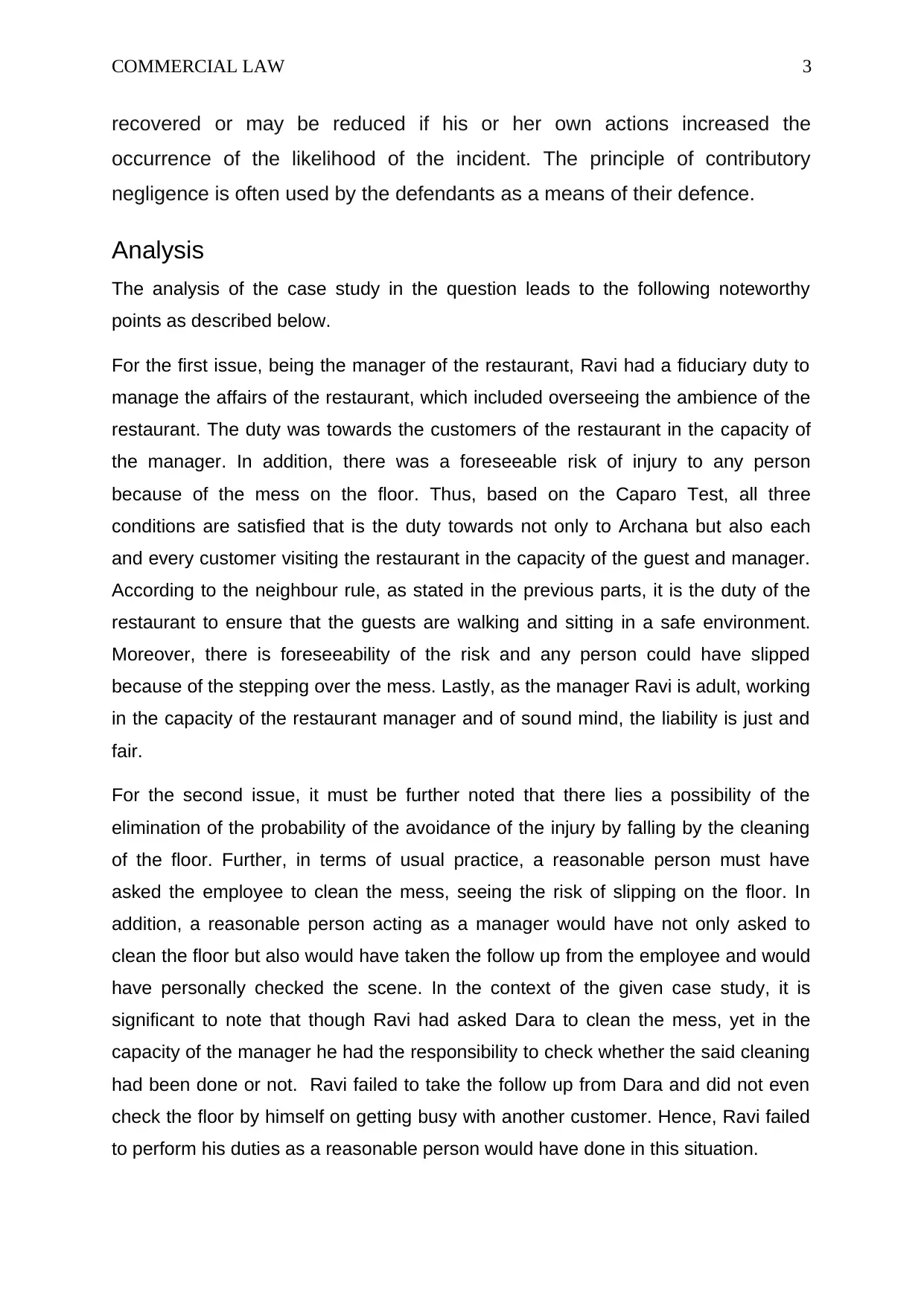
COMMERCIAL LAW 3
recovered or may be reduced if his or her own actions increased the
occurrence of the likelihood of the incident. The principle of contributory
negligence is often used by the defendants as a means of their defence.
Analysis
The analysis of the case study in the question leads to the following noteworthy
points as described below.
For the first issue, being the manager of the restaurant, Ravi had a fiduciary duty to
manage the affairs of the restaurant, which included overseeing the ambience of the
restaurant. The duty was towards the customers of the restaurant in the capacity of
the manager. In addition, there was a foreseeable risk of injury to any person
because of the mess on the floor. Thus, based on the Caparo Test, all three
conditions are satisfied that is the duty towards not only to Archana but also each
and every customer visiting the restaurant in the capacity of the guest and manager.
According to the neighbour rule, as stated in the previous parts, it is the duty of the
restaurant to ensure that the guests are walking and sitting in a safe environment.
Moreover, there is foreseeability of the risk and any person could have slipped
because of the stepping over the mess. Lastly, as the manager Ravi is adult, working
in the capacity of the restaurant manager and of sound mind, the liability is just and
fair.
For the second issue, it must be further noted that there lies a possibility of the
elimination of the probability of the avoidance of the injury by falling by the cleaning
of the floor. Further, in terms of usual practice, a reasonable person must have
asked the employee to clean the mess, seeing the risk of slipping on the floor. In
addition, a reasonable person acting as a manager would have not only asked to
clean the floor but also would have taken the follow up from the employee and would
have personally checked the scene. In the context of the given case study, it is
significant to note that though Ravi had asked Dara to clean the mess, yet in the
capacity of the manager he had the responsibility to check whether the said cleaning
had been done or not. Ravi failed to take the follow up from Dara and did not even
check the floor by himself on getting busy with another customer. Hence, Ravi failed
to perform his duties as a reasonable person would have done in this situation.
recovered or may be reduced if his or her own actions increased the
occurrence of the likelihood of the incident. The principle of contributory
negligence is often used by the defendants as a means of their defence.
Analysis
The analysis of the case study in the question leads to the following noteworthy
points as described below.
For the first issue, being the manager of the restaurant, Ravi had a fiduciary duty to
manage the affairs of the restaurant, which included overseeing the ambience of the
restaurant. The duty was towards the customers of the restaurant in the capacity of
the manager. In addition, there was a foreseeable risk of injury to any person
because of the mess on the floor. Thus, based on the Caparo Test, all three
conditions are satisfied that is the duty towards not only to Archana but also each
and every customer visiting the restaurant in the capacity of the guest and manager.
According to the neighbour rule, as stated in the previous parts, it is the duty of the
restaurant to ensure that the guests are walking and sitting in a safe environment.
Moreover, there is foreseeability of the risk and any person could have slipped
because of the stepping over the mess. Lastly, as the manager Ravi is adult, working
in the capacity of the restaurant manager and of sound mind, the liability is just and
fair.
For the second issue, it must be further noted that there lies a possibility of the
elimination of the probability of the avoidance of the injury by falling by the cleaning
of the floor. Further, in terms of usual practice, a reasonable person must have
asked the employee to clean the mess, seeing the risk of slipping on the floor. In
addition, a reasonable person acting as a manager would have not only asked to
clean the floor but also would have taken the follow up from the employee and would
have personally checked the scene. In the context of the given case study, it is
significant to note that though Ravi had asked Dara to clean the mess, yet in the
capacity of the manager he had the responsibility to check whether the said cleaning
had been done or not. Ravi failed to take the follow up from Dara and did not even
check the floor by himself on getting busy with another customer. Hence, Ravi failed
to perform his duties as a reasonable person would have done in this situation.
Paraphrase This Document
Need a fresh take? Get an instant paraphrase of this document with our AI Paraphraser
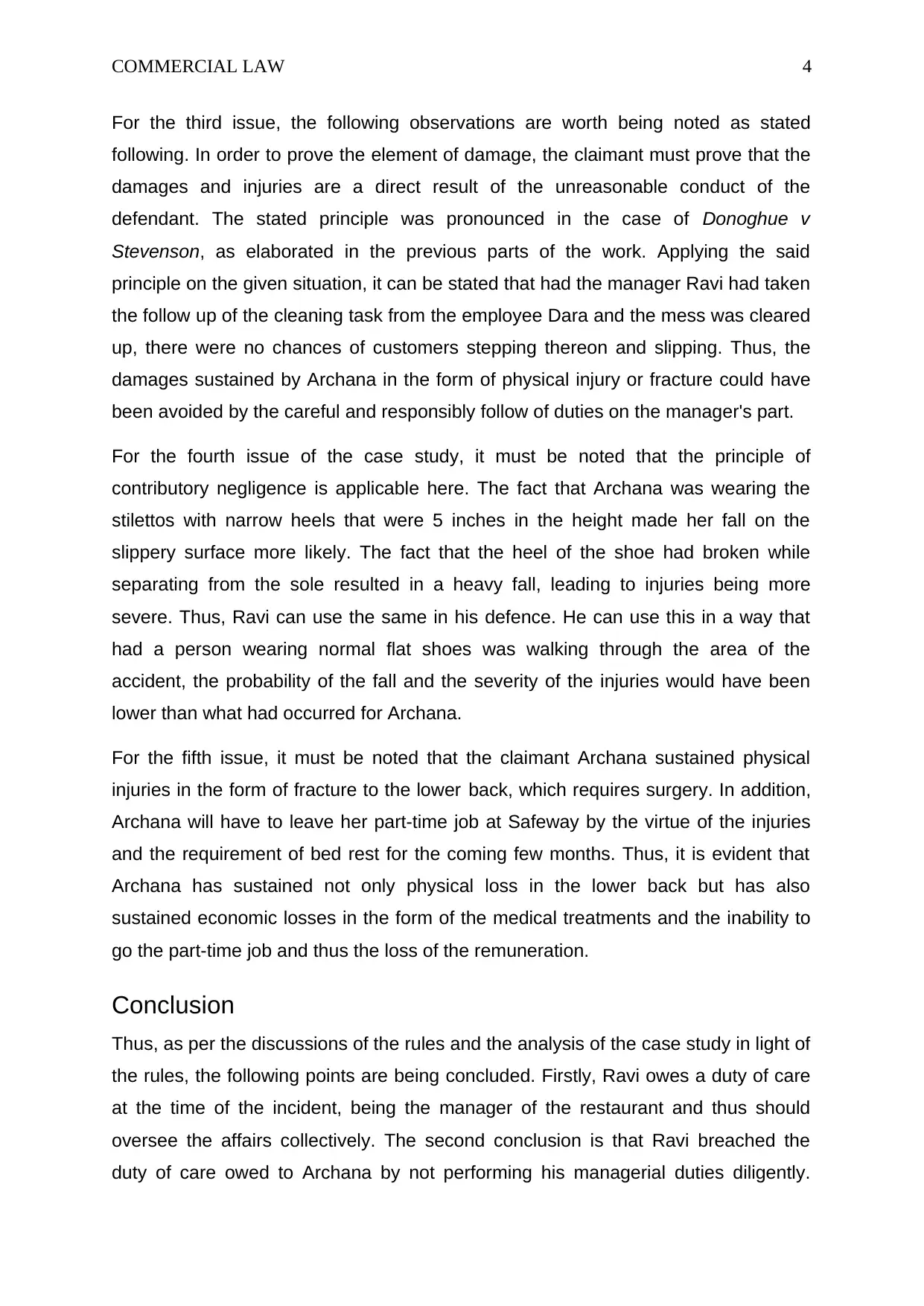
COMMERCIAL LAW 4
For the third issue, the following observations are worth being noted as stated
following. In order to prove the element of damage, the claimant must prove that the
damages and injuries are a direct result of the unreasonable conduct of the
defendant. The stated principle was pronounced in the case of Donoghue v
Stevenson, as elaborated in the previous parts of the work. Applying the said
principle on the given situation, it can be stated that had the manager Ravi had taken
the follow up of the cleaning task from the employee Dara and the mess was cleared
up, there were no chances of customers stepping thereon and slipping. Thus, the
damages sustained by Archana in the form of physical injury or fracture could have
been avoided by the careful and responsibly follow of duties on the manager's part.
For the fourth issue of the case study, it must be noted that the principle of
contributory negligence is applicable here. The fact that Archana was wearing the
stilettos with narrow heels that were 5 inches in the height made her fall on the
slippery surface more likely. The fact that the heel of the shoe had broken while
separating from the sole resulted in a heavy fall, leading to injuries being more
severe. Thus, Ravi can use the same in his defence. He can use this in a way that
had a person wearing normal flat shoes was walking through the area of the
accident, the probability of the fall and the severity of the injuries would have been
lower than what had occurred for Archana.
For the fifth issue, it must be noted that the claimant Archana sustained physical
injuries in the form of fracture to the lower back, which requires surgery. In addition,
Archana will have to leave her part-time job at Safeway by the virtue of the injuries
and the requirement of bed rest for the coming few months. Thus, it is evident that
Archana has sustained not only physical loss in the lower back but has also
sustained economic losses in the form of the medical treatments and the inability to
go the part-time job and thus the loss of the remuneration.
Conclusion
Thus, as per the discussions of the rules and the analysis of the case study in light of
the rules, the following points are being concluded. Firstly, Ravi owes a duty of care
at the time of the incident, being the manager of the restaurant and thus should
oversee the affairs collectively. The second conclusion is that Ravi breached the
duty of care owed to Archana by not performing his managerial duties diligently.
For the third issue, the following observations are worth being noted as stated
following. In order to prove the element of damage, the claimant must prove that the
damages and injuries are a direct result of the unreasonable conduct of the
defendant. The stated principle was pronounced in the case of Donoghue v
Stevenson, as elaborated in the previous parts of the work. Applying the said
principle on the given situation, it can be stated that had the manager Ravi had taken
the follow up of the cleaning task from the employee Dara and the mess was cleared
up, there were no chances of customers stepping thereon and slipping. Thus, the
damages sustained by Archana in the form of physical injury or fracture could have
been avoided by the careful and responsibly follow of duties on the manager's part.
For the fourth issue of the case study, it must be noted that the principle of
contributory negligence is applicable here. The fact that Archana was wearing the
stilettos with narrow heels that were 5 inches in the height made her fall on the
slippery surface more likely. The fact that the heel of the shoe had broken while
separating from the sole resulted in a heavy fall, leading to injuries being more
severe. Thus, Ravi can use the same in his defence. He can use this in a way that
had a person wearing normal flat shoes was walking through the area of the
accident, the probability of the fall and the severity of the injuries would have been
lower than what had occurred for Archana.
For the fifth issue, it must be noted that the claimant Archana sustained physical
injuries in the form of fracture to the lower back, which requires surgery. In addition,
Archana will have to leave her part-time job at Safeway by the virtue of the injuries
and the requirement of bed rest for the coming few months. Thus, it is evident that
Archana has sustained not only physical loss in the lower back but has also
sustained economic losses in the form of the medical treatments and the inability to
go the part-time job and thus the loss of the remuneration.
Conclusion
Thus, as per the discussions of the rules and the analysis of the case study in light of
the rules, the following points are being concluded. Firstly, Ravi owes a duty of care
at the time of the incident, being the manager of the restaurant and thus should
oversee the affairs collectively. The second conclusion is that Ravi breached the
duty of care owed to Archana by not performing his managerial duties diligently.
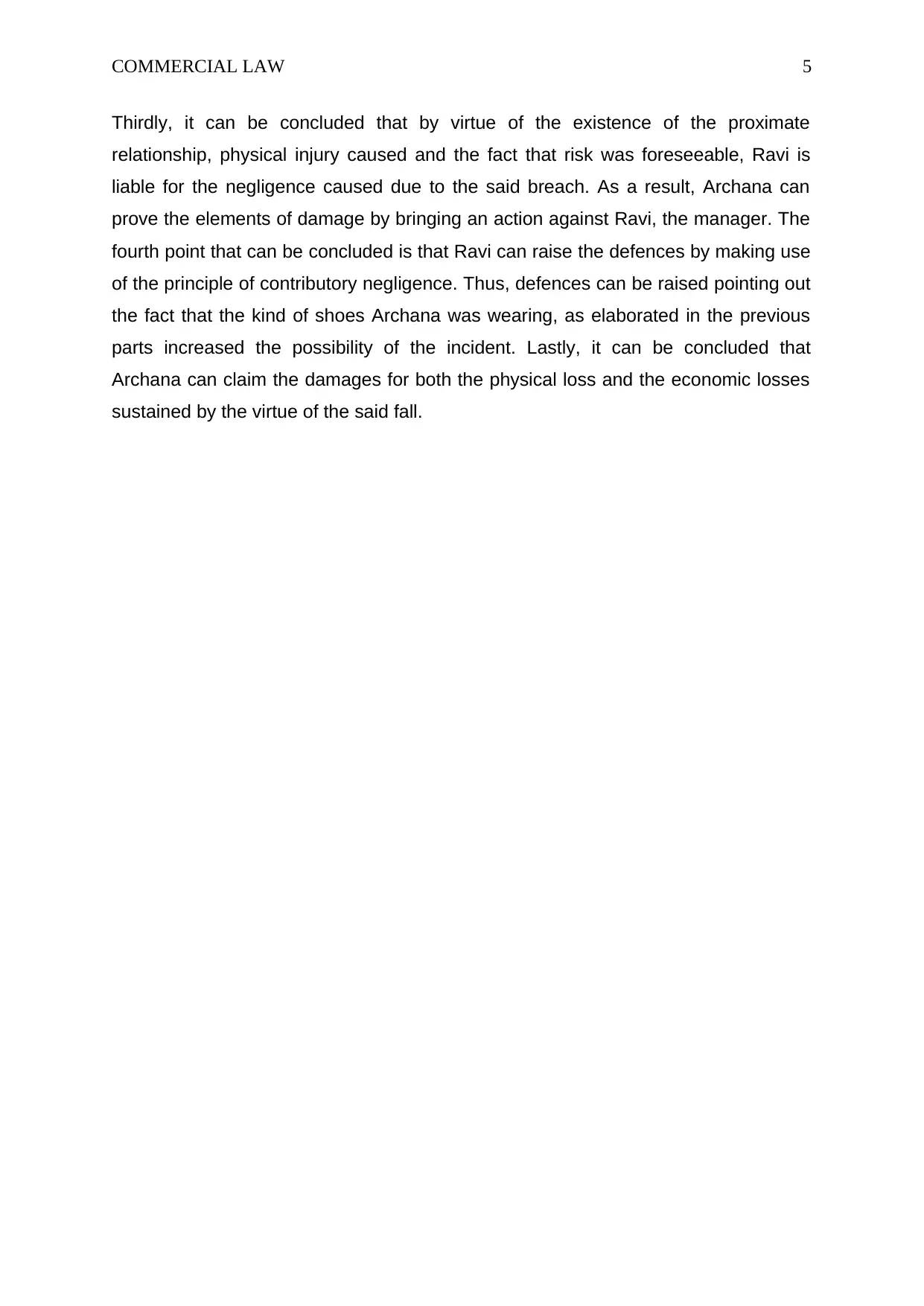
COMMERCIAL LAW 5
Thirdly, it can be concluded that by virtue of the existence of the proximate
relationship, physical injury caused and the fact that risk was foreseeable, Ravi is
liable for the negligence caused due to the said breach. As a result, Archana can
prove the elements of damage by bringing an action against Ravi, the manager. The
fourth point that can be concluded is that Ravi can raise the defences by making use
of the principle of contributory negligence. Thus, defences can be raised pointing out
the fact that the kind of shoes Archana was wearing, as elaborated in the previous
parts increased the possibility of the incident. Lastly, it can be concluded that
Archana can claim the damages for both the physical loss and the economic losses
sustained by the virtue of the said fall.
Thirdly, it can be concluded that by virtue of the existence of the proximate
relationship, physical injury caused and the fact that risk was foreseeable, Ravi is
liable for the negligence caused due to the said breach. As a result, Archana can
prove the elements of damage by bringing an action against Ravi, the manager. The
fourth point that can be concluded is that Ravi can raise the defences by making use
of the principle of contributory negligence. Thus, defences can be raised pointing out
the fact that the kind of shoes Archana was wearing, as elaborated in the previous
parts increased the possibility of the incident. Lastly, it can be concluded that
Archana can claim the damages for both the physical loss and the economic losses
sustained by the virtue of the said fall.
⊘ This is a preview!⊘
Do you want full access?
Subscribe today to unlock all pages.

Trusted by 1+ million students worldwide
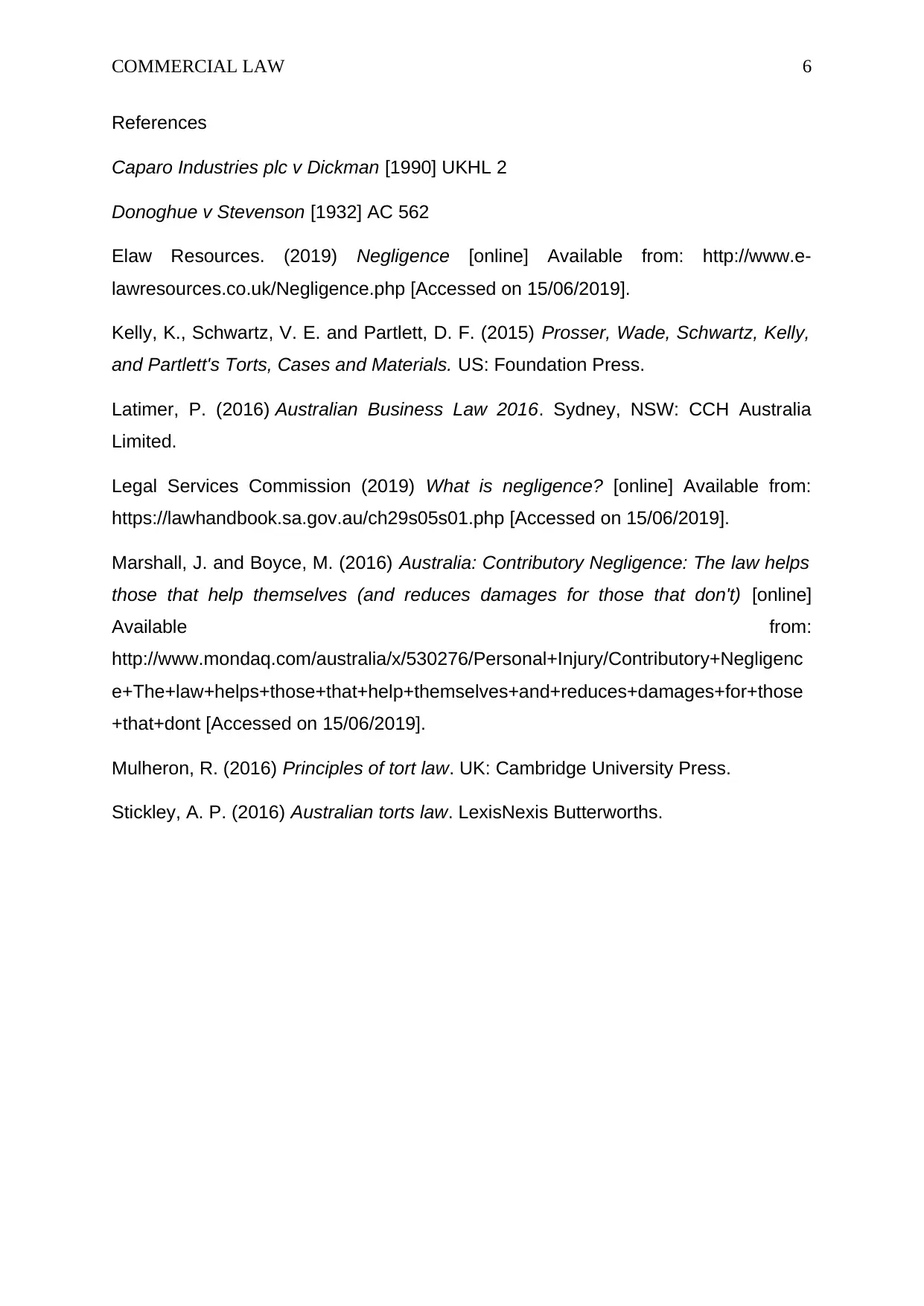
COMMERCIAL LAW 6
References
Caparo Industries plc v Dickman [1990] UKHL 2
Donoghue v Stevenson [1932] AC 562
Elaw Resources. (2019) Negligence [online] Available from: http://www.e-
lawresources.co.uk/Negligence.php [Accessed on 15/06/2019].
Kelly, K., Schwartz, V. E. and Partlett, D. F. (2015) Prosser, Wade, Schwartz, Kelly,
and Partlett's Torts, Cases and Materials. US: Foundation Press.
Latimer, P. (2016) Australian Business Law 2016. Sydney, NSW: CCH Australia
Limited.
Legal Services Commission (2019) What is negligence? [online] Available from:
https://lawhandbook.sa.gov.au/ch29s05s01.php [Accessed on 15/06/2019].
Marshall, J. and Boyce, M. (2016) Australia: Contributory Negligence: The law helps
those that help themselves (and reduces damages for those that don't) [online]
Available from:
http://www.mondaq.com/australia/x/530276/Personal+Injury/Contributory+Negligenc
e+The+law+helps+those+that+help+themselves+and+reduces+damages+for+those
+that+dont [Accessed on 15/06/2019].
Mulheron, R. (2016) Principles of tort law. UK: Cambridge University Press.
Stickley, A. P. (2016) Australian torts law. LexisNexis Butterworths.
References
Caparo Industries plc v Dickman [1990] UKHL 2
Donoghue v Stevenson [1932] AC 562
Elaw Resources. (2019) Negligence [online] Available from: http://www.e-
lawresources.co.uk/Negligence.php [Accessed on 15/06/2019].
Kelly, K., Schwartz, V. E. and Partlett, D. F. (2015) Prosser, Wade, Schwartz, Kelly,
and Partlett's Torts, Cases and Materials. US: Foundation Press.
Latimer, P. (2016) Australian Business Law 2016. Sydney, NSW: CCH Australia
Limited.
Legal Services Commission (2019) What is negligence? [online] Available from:
https://lawhandbook.sa.gov.au/ch29s05s01.php [Accessed on 15/06/2019].
Marshall, J. and Boyce, M. (2016) Australia: Contributory Negligence: The law helps
those that help themselves (and reduces damages for those that don't) [online]
Available from:
http://www.mondaq.com/australia/x/530276/Personal+Injury/Contributory+Negligenc
e+The+law+helps+those+that+help+themselves+and+reduces+damages+for+those
+that+dont [Accessed on 15/06/2019].
Mulheron, R. (2016) Principles of tort law. UK: Cambridge University Press.
Stickley, A. P. (2016) Australian torts law. LexisNexis Butterworths.
1 out of 7
Related Documents
Your All-in-One AI-Powered Toolkit for Academic Success.
+13062052269
info@desklib.com
Available 24*7 on WhatsApp / Email
![[object Object]](/_next/static/media/star-bottom.7253800d.svg)
Unlock your academic potential
Copyright © 2020–2025 A2Z Services. All Rights Reserved. Developed and managed by ZUCOL.





